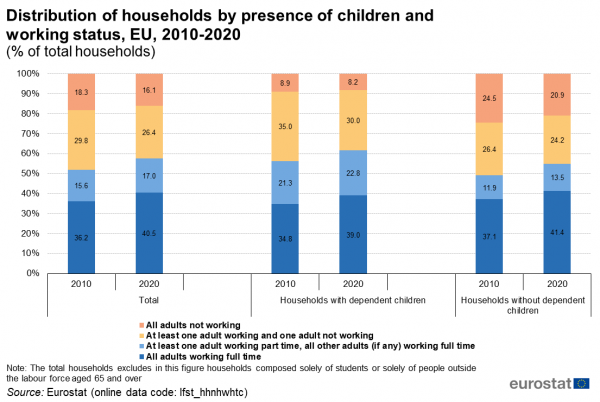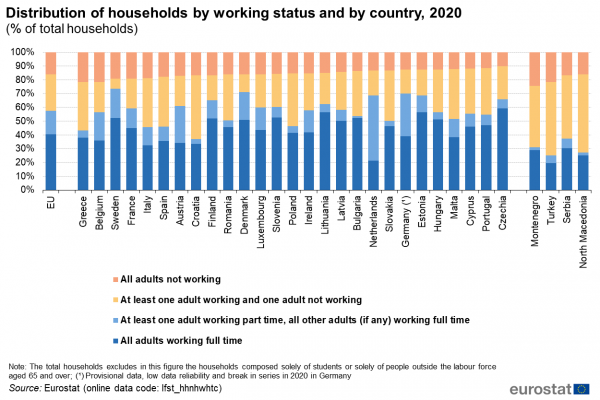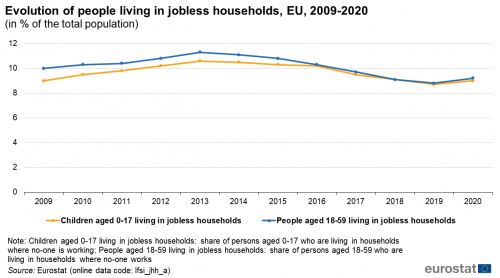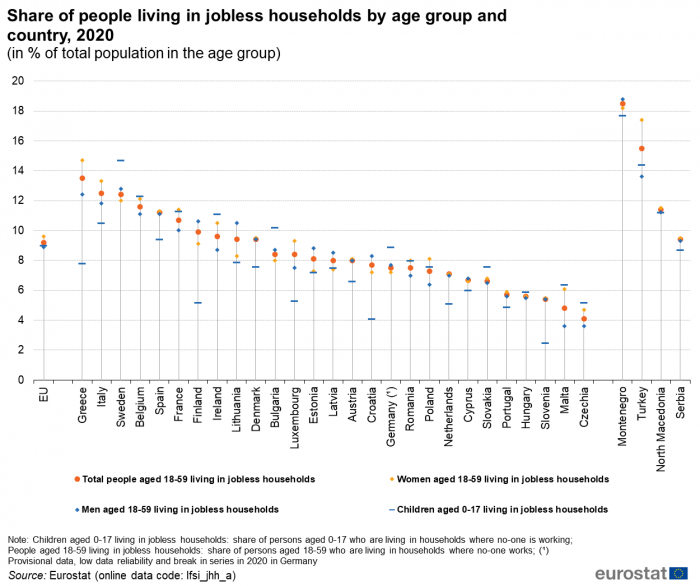Archive:Statistics on employment characteristics of households
Data extracted in July 2021.
Planned article update: August 2022.
Highlights
IMAGE from NI
This article, using the European Union Labour Force Survey (EU-LFS) data, gives insight into the employment characteristics using household information. More statistics on this topic can be found in the Eurostat database under the section households statistics (see LFS series - specific topics).
This article is also nicely complemented by the articles Employment - annual statistics, Part-time and temporary employment - statistics, Unemployment statistics and beyond and Household composition statistics.
Full article
Overview of employment in EU households
In the EU, in almost 6 in 10 households, all adults living in the household were employed in 2020 (57.5 % of all private households) as it can be seen in Figure 1. Precisely, in 40.5 % of the households, all adults were working full time; in 17.0 %%, at least one adult was working part-time and all other adults (if any) were working full time; in more than one quarter (26.4 %), at least one adult was working and one adult was not working and finally, in 16.1 % of the households, no adult was working.
Note: For comparison purpose, the households composed solely of students or solely of people outside the labour force aged 65 and over were excluded.

(% of total households)
Source: Eurostat (lfst_hhnhwhtc)
This picture differs when the presence or not of children in the household is considered. In 61.8 % of households with economically dependent children, all adults were employed against 54.9 % of households without children in 2020. These shares can be broken down as follows: all adults are working full-time in 39.0 % of households with children against 41.4 % in absence of children and, at least one adult was working part-time and all other adults (if any) were working full time in 22.8 % of households with children, that is significantly more than for households that do not include children (13.5 %). Furthermore, in 30.0 % of households with children, at least one adult was working and one adult was not working however, this share reached 24.2 % among households without children. Finally, among households with children, 8.2 % did not encompass any employed adults while this share reached 20.9 % among households without children.
Comparing the situation in 2010 and in 2020 as displayed in Figure 1, it is clear that the share of households in which all adults working increased significantly over the last decade: +4.3 p.p. for households with all adults working full time and +1.4 p.p. for households with at least one adult working part time and all other adults (if any) working full time. Similar increases are observed regardless of the presence of children. However, larger differences are visible among households including at least one adult working and one adult not working: their share decreased by 5.0 p.p. among households with children but by 2.2 p.p. among households without children. Moreover, the households in which no adults are employed decreased less for households with children than for households without children (-0.7 p.p. against -3.6 p.p. respectively).
In the EU, among the EU Member States, all adults were working in more than two thirds of the households in Sweden, Denmark, Germany, the Netherlands and Estonia, recording the highest shares in the EU (see Figure 2). However, focusing only on households in which all adults were working full-time, Czechia ranked first with 59.3 % of the households followed by Estonia (56.4 %) and Lithuania (56.3 %). Croatia and Poland recorded the highest shares of households in which at least one adult was working and one adult was not working (46.2 % and 38.1 %, respectively). By contrast, in 2020, Greece and Belgium had the highest percentage of households in which no adults were working (21.7 % for both) followed by Sweden (19.3 %), France (19.2 %), Italy (18.8 %), Spain (17.7 %) and Austria (17.0 %). Turkey showed also in 2020 a percentage above 20 % (also 21.7 %).

(% of total households)
Source: Eurostat (lfst_hhnhwhtc)
Employment, education level and presence of children in the household: gender approach
It is largely assumed that whether or not a person has children present in the household affects the way he or she participates in the labour market, furthermore the number of children and the age of the youngest child would also play a role. This section aims at presenting the employment rates according to the different features of people aged 25-54: household composition, number of children and whether the youngest child is aged less than 6 years. These employment rates are shown in Figure 3 for the total population also broken down by education level.

(in % of the population aged 25 to 54)
Source: Eurostat (lfst_hheredty) and (lfst_hheredch)
First of all, even if differences are visible according to the household's characteristics, the level of education appears to be determinant in the level of employment of each category and this applies especially for women.
Regardless of education and presence of children, the share of employed women aged 25 to 54 living in a single adult household amounted to 78.3 % and was slightly higher than the share of employed women living in a couple (75.8 %). In addition, 67.6 % of women living in another type of household were employed in 2020. More noticeable differences are observed for men: the employment rate of men aged 25-54 and living in a couple reached 91.6 %, while it amounted to 81.6 % for the men living in a single adult household and 76.2 % for men living in another type of household.
In 2020, the employment rate of women with children was 72.2 %, 4.6 p.p. below the employment rate of women without children (76.8 %). For men, it is the opposite, the presence of economically dependent children seems to play a positive influence on the employment rate: 9 in 10 men with economically dependent children (90.0 % exactly) were employed against 8 in 10 for men without children (80.9 %).
With respect to the number of children, the employment rate of women with one child or two children were actually very close in 2020 in the EU: 74.2 % and 74.3 % respectively. However, in comparison, the employment rate of women with three children or more is significantly below as employed women with three children or more stood for 59.1 %. Furthermore, female employment shows large differences according to the level of education. The higher the number of children, the wider the gap between women with low and high level of education: 32.0 p.p. for women having one economically dependent child in the household, 38.6 p.p. for women having two children and 48.4 p.p. for women with three children or more. Indeed, women with a high level of education and three children or more maintained an employment rate of 79.9 %, while the employment rate of women with a low level of education and three children or more dropped to 31.5 %. Among men with children, the employment rate of men with two children was the highest, reaching 92.4 %, followed by those with one child (88.7 %) and three children or more (86.7 %). The highest employment rate amongst all categories was recorded for men with a high level of education and two children amounting to 96.2 % in the EU. Nevertheless, the employment gap between men with a low and a high level of educational attainment and with children is not as wide as for women whatever the number of children (from 14.0 p.p. for men with two children to 23.8 p.p. for men with three or more children).
Looking at men and women for which the youngest child is aged less than 6 years, a great disparity is also observed between people with a low and a high level of education and between genders. The employment rate of women with at least a child aged less than 6 years was 35.4 % for women with a low level of education, 62.0 % for those with a medium level and 79.5 % for those with a high level of education, producing a gap of 44.1 p.p. between the low and the high level of education. Moreover, the share of employed men with a child aged less than 6 years was 77.3 % for those with a low level of educational attainment, 92.3 % among men with a medium level of education and 95.7 % among men with a high level of education.
Finally, the fluctuations between categories of household are less pronounced for women with a high level of education, the maximum difference is 9.6 p.p. among household categories for women with a high educational attainment level against 21.5 p.p. and 18.9 p.p. for women with a low and a medium level of education, more sensitive to the presence of children. The same pattern is observed for men but to a lesser extent.
The figure at the top of the article indicates the employment rate of men and women aged 25-54 having or not children by country in 2020. At EU level, the share of employed women aged 25-54 having children was 72.2 % in 2020 against 76.8 % for women without children. Conversely and as previously presented in this section, men aged 25-54 with children had in 2020 a higher employment rate than men without children (90.0 % against 80.9 %). The highest shares of employed women with children, all above 80 %, were recorded by Slovenia (86.2 %), Sweden (83.5 %), Portugal (83.0 %), Lithuania (82.6 %), Denmark (82.2 %),the Netherlands (80.7 %) and Finland (80.3 %). The lowest rates were reported by Italy (57.3 %), Greece (61.3 %) and Spain (66.2 %) where less than two thirds of women with children were employed. Another relevant finding is that in Czechia, Malta and Slovenia, 95 % or more of men with children aged 25-54 were employed in 2020, which are the highest rates found in the EU Member States.
The widest gaps between the share of employed women and men having children were found in Italy, Greece, Hungary, Czechia, Malta, Romania, Slovakia and Ireland. In all these countries, the differences between the employment rate of women and men with children ranked from 28.9 p.p. in Italy to 20.7 p.p. in Ireland. At EU level, the gender gap was 17.8 p.p. between both categories. By contrast, Portugal, Slovenia and Lithuania recorded differences lower than 10 p.p. It also appears that the employment rate of women with children seems to be higher in the countries showing the narrowest gender gaps. The results change drastically in absence of children. At EU level, the difference between the employment rate of men and women with no children was 4.1 p.p. in 2020 and was above 10 p.p. in only 3 countries (i.e. Italy, Greece and Romania).
Part-time employment for men and women, with and without children
Figures 4 shows the effects for both male and female population. Note that all results are limited to persons aged 25-54 years, so that different national situations for being a pupil, student and/or retired person do not influence the results and do not compromise the comparability between countries.
In 2020, almost one third of women aged 25-54 years with children worked on a part-time basis in the EU (32.6 %). Figure 4 shows that the share of part-timers differs greatly between men and women and that the gender gap becomes even wider when persons have children. In all countries, the proportion of women with one or more children that are employed on a part-time basis is higher compared to men with Montenegro as exception. The gap between men and women with children for the part-time employment rate was 27.5 percentage points (p.p.) in the EU in 2020. Concerning men and women without children, the gap was narrower and amounted to less than half of the gap observed for people with children (12.5 p.p.).
In Romania and Bulgaria, differences between men and women and between people with and without children, are rather small. In these two countries, the proportion of part-time workers is relatively low. In Denmark, Romania, Bulgaria, Lithuania and Greece, there are almost no differences (less than 1 p.p.) in the share of part-time employment between women with or without children. However, the most common pattern is that having children does influence the part-time employment among women. For example, in Germany 29.8 % of women without children worked part-time in 2020 against 66.9 % of women with children, in Austria these rates were 32.3 % against 64.4 % and in the Netherlands 58.5 % against 81.7 % . This suggests that women in these countries tend to shift to part-time work from the moment they have children.

(in % of employed people aged 25-54)
Source: Eurostat (lfst_hhptechi)
Children and adults in jobless households
In 2020, in the EU, 9.0 % % of children aged 0-17 and 9.2 % of people aged 18-59 were living in jobless households. In 2013, these shares reached 10.6 % for children aged 0-17 a %nd 11.3 % for people aged 18-59 which were the highest shares recorded on the overall period 2009-2020. Both categories steadily decreased during the period 2014-2019. In 2019, 8.7 % of children aged 0-17 and 8.8 % of people aged 18-59 were living in households where no-one works but they both increased in 2020, by 0.3 p.p. and 0.4 p.p. respectively (see Figure 5).

(in % of the total population)
Source: Eurostat (lfsi_jhh_a)
As shown in Figure 6, more than 10 % of children lived in 2020 in jobless households in Sweden (14.7 %), Belgium (12.3 %), France (11.3 %), Ireland (11.1 %), Italy (10.5 %) and Bulgaria (10.2 %) while it concerned less than 5 % of the children aged 0-17 in Slovenia (2.5 %), Croatia (4.1 %) and Portugal (4.9 %). In Greece, Italy and Sweden, more than 12 % of people aged 18-59 lived in households where no-one works (13.5 %, 12.5 % and 12.4, respectively) and less than 5 % in Malta and Czechia. The largest differences between men and women were recorded in Malta (2.5 p.p.), Greece (2.3 p.p.), Lithuania (2.2 p.p.), Ireland and Luxembourg (both 1.8 p.p.). In two thirds of the EU Member States, the share of women living in jobless households is higher than for men.

(in % of total population in the age group)
Source: Eurostat (lfsi_jhh_a)
Source data for tables and graphs
Data sources
Source: All statistics presented in this article are derived from the European Union Labour Force Survey (EU-LFS). The EU-LFS is the largest European household sample survey providing quarterly and annual results on labour participation of people aged 15 and over. It covers residents in private households and excludes those in collective households. Conscripts in military or community service are not included in the results. The EU-LFS is based on the same target populations and uses the same definitions in all countries, which means that the results are comparable between the countries.
Under the specific topic 'Households statistics', the EU-LFS currently covers statistics on household composition and number and size of households.
Reference period: Yearly results are obtained as averages of the four quarters in the year.
Coverage: The results from the EU-LFS currently cover all European Union Member States, the United Kingdom, the EFTA Member States of Iceland, Norway, Switzerland, as well as the candidate countries Montenegro, North Macedonia, Serbia and Turkey. For Cyprus, the survey covers only the areas of Cyprus controlled by the Government of the Republic of Cyprus. Nevertheless, EU-LFS household data are not available for Iceland, Norway, Switzerland.
Definitions: The concepts and definitions used in the survey follow the guidelines of the International Labour Organisation.
•Employment covers persons aged 15 years and over (16 and over in Spain, Italy and the United Kingdom, 15-74 years in Estonia, Latvia, Hungary, Finland, Sweden, Norway and Denmark, and 16-74 years in Iceland), living in private households, who during the reference week performed work, even for just one hour, for pay, profit or family gain, or were not at work but had a job or business from which they were temporarily absent, for example because of illness, holidays, industrial dispute or education and training. The LFS employment concept differs from national accounts domestic employment, as the latter sets no limit on age or type of household, and also includes the non-resident population contributing to GDP and conscripts in military or community service.
•The distinction between full-time and part-time work is generally based on a spontaneous response by the respondent. The main exceptions are the Netherlands and Iceland where a 35 hours threshold is applied, Sweden where a threshold is applied to the self-employed, and Norway where persons working between 32 and 36 hours are asked whether this is a full- or part-time position;
•Unemployment covers persons aged 15-74 (16-74 in Italy, Spain, the United Kingdom and Iceland) who were not employed during the reference week, were currently available for work and had either been actively seeking work in the past four weeks or had already found a job starting within the next three months.
Definitions of indicators reported in this publication are available on the EU-LFS Statistics Explained website: EU Labour Force Survey (Statistics Explained)
Context
The EU-LFS is the largest European household sample survey providing quarterly and annual results on labour participation of people aged 15 and over as well as on persons outside the labour force. It covers residents in private households. The EU-LFS is an important source of information about the situation and trends in the EU labour market. Each quarter around 1.8 million interviews are conducted throughout the participating countries to obtain statistical information for some 100 variables. Due to the diversity of information and the large sample size the EU-LFS is also an important source for other European statistics like Education statistics or Regional statistics.
Direct access to